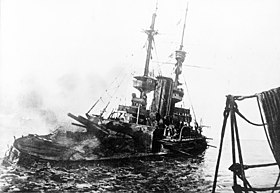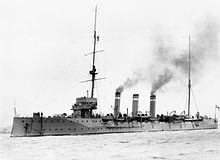HMS Irresistible (1898)
|
|
|
|---|---|
 The sinking HMS Irresistible |
|
| Overview | |
| Type | Ship of the line |
| Shipyard | |
| Keel laying | April 11, 1898 |
| Launch | December 15, 1898 |
| Commissioning | February 4, 1902 |
| Whereabouts | March 18, 1915 by a mine in the Dardanelles dropped |
| Technical specifications | |
| displacement |
14,600 tn.l. , Max. 16,105 tn.l. |
| length |
Lpp. 125.3 m (411 ft); |
| width |
22.9 m (75 ft) |
| Draft |
8.2 m (26.75 ft) |
| crew |
780 men (peace) |
| drive | |
| speed |
18 kn , |
| Range |
5550 nm at 10 kn |
| Armament |
|
| Fuel supply |
?? t coal |
| Belt armor |
up to 231 mm (9 in) |
| deck |
25–76 mm (1–3 in) |
| Armored bulkheads |
231–305 mm (9–12 in) |
| Towers |
203-254 mm (8-10 in) |
| Barbeds |
305 mm (12 in) |
| Casemates |
152 mm (6 in) |
| Command tower |
360 mm (14 in) |
The HMS Irresistible was a formidable class battleship of the British Royal Navy , which initially served in the Mediterranean and from 1908 in the English Channel . She took part in the First World War and sank in the Dardanelles in 1915 by a sea attack .
period of service
The HMS Irresistible ran on 15 December 1898 as the second ship of Formidable class in Chatham in a very imperfect state unusually early from the pile , because you the slipway for the construction of the sister ship HMS Venerable wanted to get free. In October 1901 it was finished and had completed its tests. The cost of construction was just over £ 1.1 million . The main armament of the ship of the line consisted of four 12- inch (305 mm) type Mk IX guns in two twin turrets and twelve 6-inch (152 mm) type Mk VII guns in side casemates , both types of weapons being more modern than the similar Guns in the previous classes. The crew consisted of 780 men. The ship belonged to the first group of three ships of the class, the second group of which is also referred to as the London class and the third, the last two ships built over two years later, as the Queen class. In addition to the new armament, the draft contained elements of both preceding classes. The Japanese naval flagship Mikasa was practically a sister ship of the Formidable class.
Operations in peace
On February 4, 1902, HMS Irresistible was commissioned as the second ship of the class after HMS Implacable with the service in the Mediterranean fleet . Here she replaced the old tower ship HMS Devastation , which was last used as a guard ship in Gibraltar . During her mission in the Mediterranean, the Irresistible was involved in two accidents. On March 3, 1902, she collided with the Norwegian steamer Clive in fog and suffered considerable damage. On October 5, 1905, she ran aground in Malta and was repaired there. A second overhaul took place in Malta between October 1907 and January 1908. All sister ships of the Irresistible gradually came to the Mediterranean fleet, namely in 1902 HMS Bulwark as flagship , HMS London and Venerable , in 1904 HMS Formidable and the newly commissioned HMS Queen , which later replaced Bulwark as flagship, and HMS Prince of Wales . In principle, the Royal Navy also used different ships of the line in a fleet or station, as the individual classes did not differ significantly. In April 1908 the Irresistible was transferred to the Canal Fleet , where the Implacable was already on duty. There she collided with a schooner in fog on May 4, 1908 , without suffering damage. In 1909 she became the flagship of the Nore Division and in May 1910 reduced the crew for the first time to a small tribe as part of the new reservist system introduced in the Royal Navy, but left already out of service on June 1, 1910 to be overhauled at the shipyard in Chatham. After completion of the overhaul, the Irresistible returned to Chatham on February 28, 1911 in service for the 3rd Division of the Home Fleet in the Nore and in 1912 was assigned to the newly formed 5th Battle Squadron, in which all eight ships of the Formidable class were combined were. Only the Queen as an artillery training ship was in constant use, while the other ships were mostly only used for exercises. Due to the construction of the HMS Dreadnought and its successors, the Irresistible and her sister ships were technically obsolete as early as 1907 - a few years after their commissioning. However, the older ships of the line still had to perform important tasks, as the newer battleships came to the fleet slowly and in small numbers.
War effort
The HMS Irresistible was part of the "5th Battle Squadron" (5th battle squadron) of the Canal Fleet. After the start of the First World War, she brought parts of the Portsmouth Marine Battalion to Ostend in August 1914 , where this unit was supposed to help defend the city against the advancing Germans . From October to November 1914 she was part of the Dover Patrol and gave artillery support to the British Expeditionary Force in Belgium . On the morning of November 26, 1914, the squadron suffered its first loss when Bulwark , anchored off Sheerness , was destroyed by a massive ammunition chamber explosion. On December 30, 1914, the Irresistible , the Implacable and the Formidable ran out of an artillery exercise off the Isle of Portland , accompanied by the cruisers HMS Topaze and HMS Diamond , but without destroyer security. The association stayed at sea after its completion, because the bad weather meant that there was no suspicion of danger from German submarines. Nevertheless, the U 24 operating in this area managed to fire a torpedo on the Formidable at the end of the formation on January 1, 1915 at 02:20 a.m. and to score a hit on the port side at the level of the first boiler room (partially also from the starboard side ). The ship quickly got a list of about 20 °. 45 minutes later, U 24 launched another attack, which resulted in another hit. The ship was now listing increasingly to starboard. An orderly evacuation was not possible because of the high swell, which was accompanied by strong winds, rain and darkness. Only four lifeboats could be launched, one of which capsized.
For its part, the Formidable capsized and sank around 04:45 a.m. Captain Noel Loxley, who had stayed on the bridge to the end, went down with his ship. 80 men were rescued by the cruisers Topaze and Diamond , and another 70 by a trawler from Brixham . A pinasse with originally 71 crew members was only sighted from land on the following day: 48 men could be rescued alive; three more died of them. A total of 547 crew members lost their lives when the ship went down.
In February 1915, the Irresistible was moved together with her five sister ships and other older ships of the line to the Dardanelles , where they were used in the Battle of Gallipoli . On February 18, 1915, she was involved in a first attack on the Turkish forts and also took part in the massive naval attack under Admiral John de Robeck on March 18, 1915, with which a British- French naval formation tried to force the passage through the Dardanelles. In the course of this operation, the Irresistible ran into a sea mine on the way back at 16:16 local time and was badly damaged. The mine was part of a barrier that the Turkish mine- layer Nusret (Germaniawerft 1911, 365 t) had laid unnoticed a few days earlier in front of the actual mine barriers in an area that the Allies had used to turn their ships bombarding the forts. The French Bouvet had hit one of the mines about two hours earlier without this having been recognized as a mine hit when the ship exploded and sank very quickly. The Ocean and the battle cruiser Inflexible were later hit by mines here.
Loss of the Irresistible
Almost the entire crew except for the captain and some volunteers was taken over by the Wear and brought to the Queen Elizabeth . The starboard engine room filled up very quickly and the men deployed there almost all died. Finally the middle bulkhead broke, the port engine room was flooded and the Irresistible had no more engine power available. She listed heavily to starboard and sank deeper and deeper. To do this, they drove into range of the Turkish coastal batteries, which they fired heavily and scored several hits. Then both heavy towers also failed. An attempt by the ocean to tow the Irresistible , which was slowly drifting towards the coast , and to rescue it, failed because of the strong list of the ship and the heavy Turkish artillery fire. The Ocean took over the remaining crew members, but ran into a mine at 6:05 p.m. and received a direct artillery hit shortly afterwards. Their damage developed similarly to that on the Irresistible . Her crew and the men taken over from the Irresistible could be rescued by the destroyer escorts and the retreating Allies left the two badly hit ships of the line behind. They sank after 8:00 p.m. on the evening of March 18; the destroyer Jed , who was later sent into the strait to torpedo them so that they would not fall into the hands of the enemy, no longer found them. With the sinking of the Irresistible , around 150 men are said to have died, according to other sources only 16.
See also
literature
- RA Burt: British Battleships 1889-1904 . Arms and Armor Press, London 1988, ISBN 0-85368-914-8 .
- Randal Gray (Ed.): Conway's All The World's Fighting Ships 1906-1921 , Naval Institute Press, Annapolis, Maryland 1985, ISBN 0-87021-907-3
- Randolph Pears: British Battleships 1892-1957. The great Days of the Fleets. Putnam, London 1957 (also: Godfrey Cave, London 1979, ISBN 0-906223-14-8 ).
Web links
- HMS Formidable , Irresistible and Implacable
- Sinking of HMS Irresistible and HMS Ocean (PDF; 129 kB) Imperial War Museum
- HMS Irresistible pictures, dates and the list of dead
